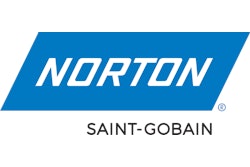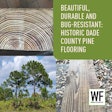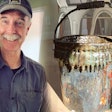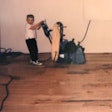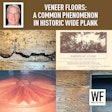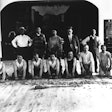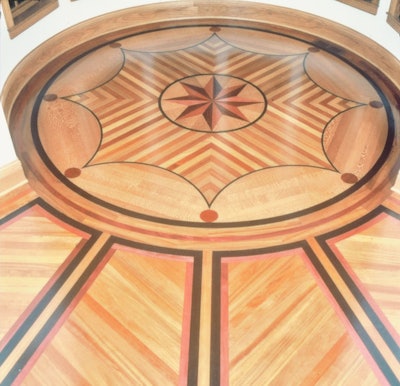
WFB went through its archives and realized some of the amazing craftsmanship of past Floor of the Year winners belonged on the internet, and WFB Throwback was born. The following article originally appeared in the August/September 1993 issue of WFB (then called Hardwood Floors):
Floor of the Year, Residential Category: Hardwood Renovations, Terre Haute, Ind.
A doctor’s study—“a retreat,” says Chuck Crispin of Hardwood Renovations, “some place where he can open his mail and get away from the kids”—is the site of the NWFA’s 1993 Floor of the Year in the residential category.
At 11 feet, 9 inches in diameter, the circular portion of the winning floor is the room’s masterstroke, drawing the eye like an arrow to a target. (The middle of the five rays of purpleheart, wenge and jatoba bisects the doorway and points directly to the central axis of the starburst feature within the circle.) Crispin says the design was an attempt to project the same “architectural grandeur” as the rest of the house, and to respond to the architectural elements of the room—but above all, he says, it satisfied the home owners’ main criterion: “They wanted a real zapper.”
Although the majority of the floor was constructed on-site, the circles of wenge, purpleheart and jatoba—as well as the curved bands of wenge that create the scalloped effect between the radiating stripes of cumaru and jatoba and the half-rounded fields of lacewood—were laser-cut by DLA Inc. Crispin is quick to credit Rick Liudahl of DLA “for first, being able to keep up with how we wanted the thing to look, and second, for being able to produce it.”
Assisted by his brother John, Mark Wehr and Craig Spicer, Crispin began work at the eight-pointed star, made of padauk and purpleheart with rounded lacewood triangles, all bordered by a band of wenge, and moved outward through five separate work stages. During the second stage, each cumaru and jatoba strip was cut and sanded to fit snugly to the wenge bands, and each was tongue-and-grooved, glued and hand-nailed, and the feather joints routed and slip-tongued.
RELATED: Words of Wisdom: What Did You Expect to Find Down There?
Cutting through these woods to join this section of the floor with the scalloped lacewood proved to be the project’s most difficult step.
“The real difficulty in putting something like this together is that you’re plunge-routing through wood that’s incredibly tough,” says Crispin. “The resistance you get when you try to cut it is tremendous, and the plywood template we were using actually dented. It gave me a wobbly line and pulled me maybe 1⁄64th of an inch inside the imaginary pencil line that would have been there. That would have left me with a fill area, which I detest. We thought about trying to harden the template somehow, or even producing a steel template, but we ended up getting three different sized pattern-cutting bits from three different companies and making three passes with the router, each going 1⁄4-inch deeper than the last.” Redoing this cut meant that the wenge definition strip was increased from 1⁄2-inch to 5⁄8-inch wide.
In the fifth stage, the working area of the study, the jatoba “windows” between the purpleheart, wenge and jatoba rays were “feathered in order to give an increased visual interest,” Crispin says, but also “as a practical matter, too. I didn’t want to join any more boards than I absolutely had to.”
Crispin’s first experience with wood was when he cut and hauled lumber in Luxembourg for two years, after which he returned to this country to be a general contractor. Eventually, he says, he “became a slave to hardwood floors.”
His business “took a real turn” three years ago, when Allan Pyne of Sunshine Flooring Company came to Terre Haute to install what would be voted as NWFA’s 1991 Floor of the Year, and hired Crispin to help out.
In the process, Crispin says, Pyne became his mentor.
RELATED: WFB Throwback: Allan Pyne's 1999 Winning Wood Floork
“I loved working with Allan from the very first day,” Crispin says. “He showed me a bunch of stuff I’d never seen before, and since then, he and I have been on the phone quite a bit. I use him as a sounding board and a reference for a lot of my projects. I owe a lot to Allan personally for being a mentor, someone who’s given me a real high mark to shoot for.”
Crispin says he asked Pyne how he got to do this kind of work. “In his gruff way he said, ‘If you want to do work like this you’ve got to go out and make it, because nobody’s going to come and ask you to do it,’” Crispin says. “We started rattling contractors’ cages, and pushing designs at everybody, and ever since then, at virtually every installation where I’ve had the opportunity, I’ve tried to do some kind of custom work.”
Suppliers:
Abrasives: Norton Abrasives | Buffers: American Sanders | Finish: DuraSeal | Sanders: Hummel | Wood vents: All American Wood Register Co.
See the floor that won Crispin the 2019 Readers' Choice Design Award here.















